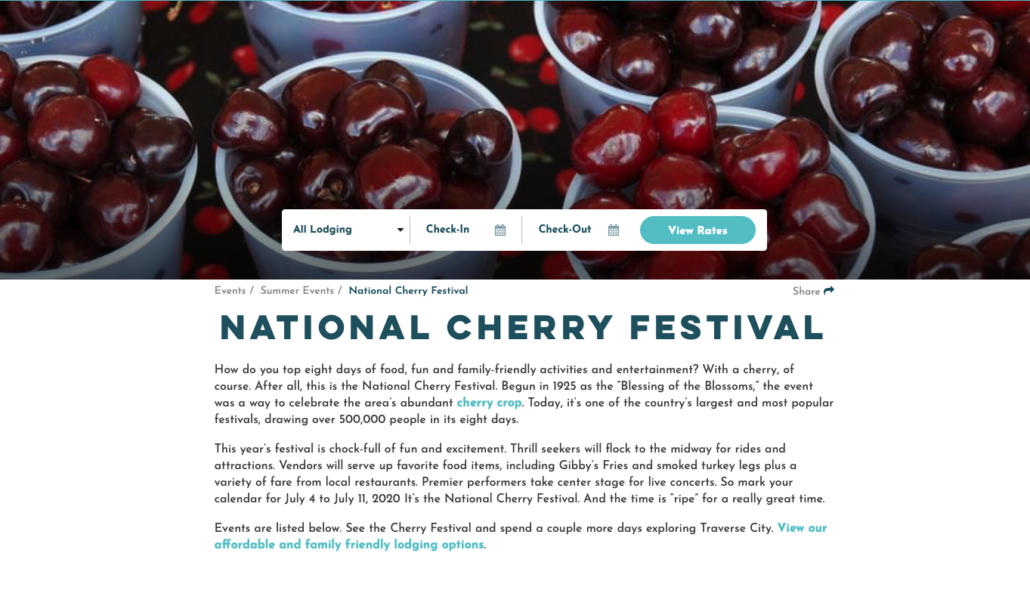How to Decide What Events to Post about on Social

Events are major destination-drivers and a great way to spread awareness about them is by posting them across social media. Many destinations have several events going on in a single day, let alone over weeks and months. It’s easy to get things muddled up in terms of what happenings take precedence over others. So, how exactly are you supposed to know which ones to post about? Here’s our step-by-step guide on how to decipher what events to prioritize in your social feeds.
Is this event likely to convert overnight stays?
Start by asking yourself this question: “Is someone likely to travel to your destination and stay in a hotel for the event?” If the event is a small or medium concert, a farmer’s market or even a small art fair, the answer is probably “no.” However, a three-day annual fair, a music festival or an event that is unique to your destination, like Dublin, Ohio’s Irish Festival, is definitely worth posting about.
These types of events are considered “destination drivers”. The event is big enough and niche enough for visitors to plan ahead for. We consider these “major events” that will likely require visitors to have to stay overnight. Typically, specific, unique, niche events fall into this category. Check out the example below of Dublin, Ohio’s Irish Festival.
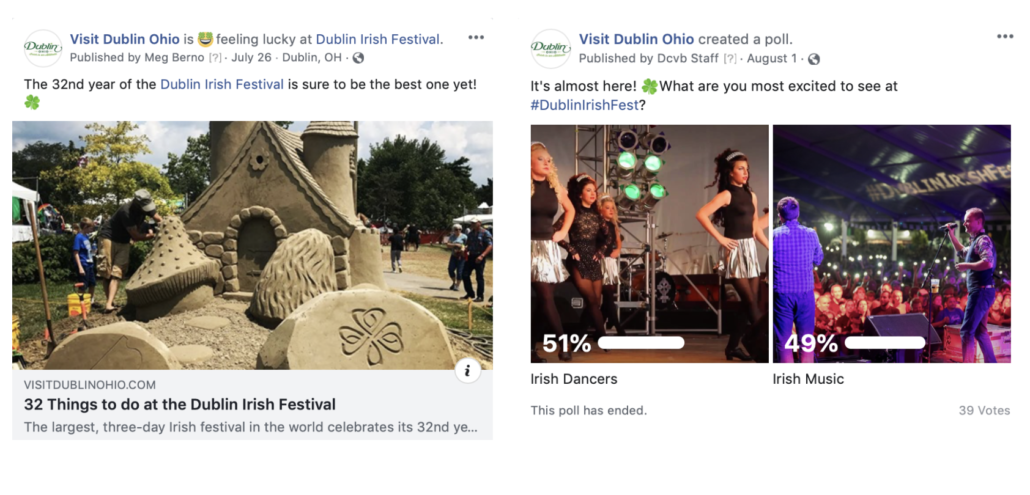
Is the event relevant to a current leisure traveler?
If the event isn’t likely to convert overnight stays ask whether or not the event is relevant to someone traveling on a leisurely basis. This means you should be posting about things that draw people into your destination rather than things that are tailored to attracting locals. Here are a few instances of events that would be primarily attended by locals:
- Storytime at the local library
- Salsa night downtown
- Midnight movie showings at the local theater
In other words, if you can find it anywhere, it’s probably not relevant to a leisure traveler. However, if there’s a superlative like; “Biggest Salsa Night in the US”, then it’s worthy of being placed on the content calendar!
A fantastic example of a unique destination-driving event is the National Cherry Festival in Traverse City, Michigan. This highly populated, 8-day festival, only takes place in Traverse City, making it a significant destination-centric event.
Does the event support a major partner or a larger DMO initiative?
There are ‘special case’ scenarios when an event doesn’t meet the criteria of the first two questions. Ask yourself if the event supports a major partner or larger DMO initiative. This may be different for a variety of destinations, but regardless, it’s a critical question to ask yourself! This essentially means that if your DMO works hard to promote a specific event that supports your organization or a local partner, it’s important to post about it across social.
A great example of this is the commonly held “Restaurant Week.” Restaurant Weeks take place across the US, and although it doesn’t typically convert overnight stays, if you’ve put a lot of time and effort into coordinating the event, it’s an excellent opportunity to feature your local restaurant partners.
Another instance that would match these credentials would be a smaller event that supports a key element of your destination. Suppose that your major attraction like an Air & Space Museum was holding a fundraising event to raise funds for a major expansion. You could use the opportunity to provide more awareness about the museum and exciting new additions coming in the future!
Check out this easy to follow flow chart to help make these decisions quickly. Better yet, share it with your partners so they know what you promote and what you don’t!
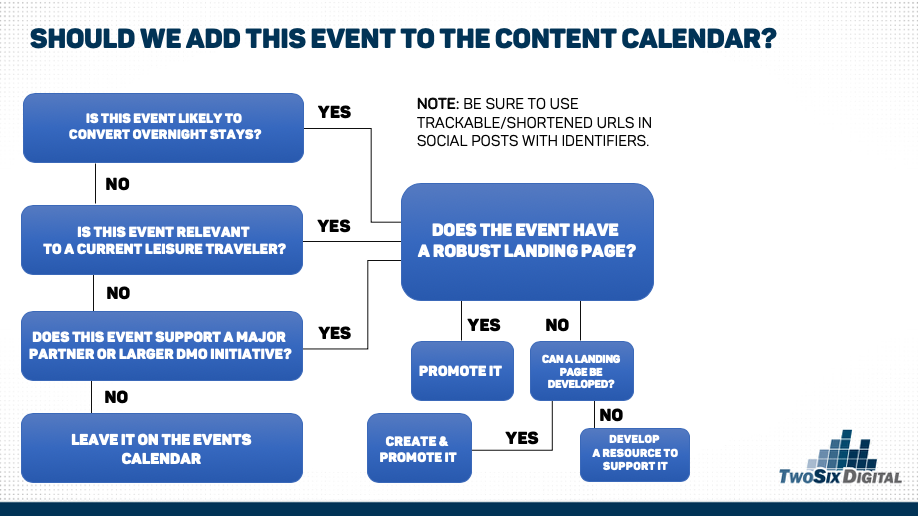
What’s Next?
Once you’ve decided whether or not the event is going to make it onto your content calendar, you need to make sure that you have a robust landing page to accommodate the post. If an event meets any of the previous three criteria but doesn’t have a landing page on your website, take time to create a dedicated page to support it. Landing pages are absolutely key!
TwoSix Tip: Try to get away from using the term “event listing” at all costs. You need to build useful landing pages that ignite the discovery process. Just say no to event listings. Say yes to mobile-friendly, fully-integrated landing pages that extend the story for your website users. And, don’t forget those call-to-action items either!
Adding events into your weekly and monthly content plan is an excellent way to spread awareness of what is happening in your destination. Just be sure to select the right ones that help you reach your organization’s goals of driving overnight visitation.
For more ways on how to best promote your destination, be sure to follow us across social media at the links below and subscribe to our newsletter. Not sure how to take the next step? Click below to contact us for more assistance.
How to Generate More Traffic to Your Tourism Blog

Your tourism blog is one of the best ways to tell your story to consumers. Not only should you consistently update your blog to inform users about your destination and maintain sustainable SEO, but you should also be strategic about where you are distributing your blog once it’s live on your website.
We recommend living by the “5 Rule” which means that every piece of content on your website or blog has the potential to be shared at least five different ways after it is published on your site. Read on to learn how to generate more traffic to your tourism blog in no time!
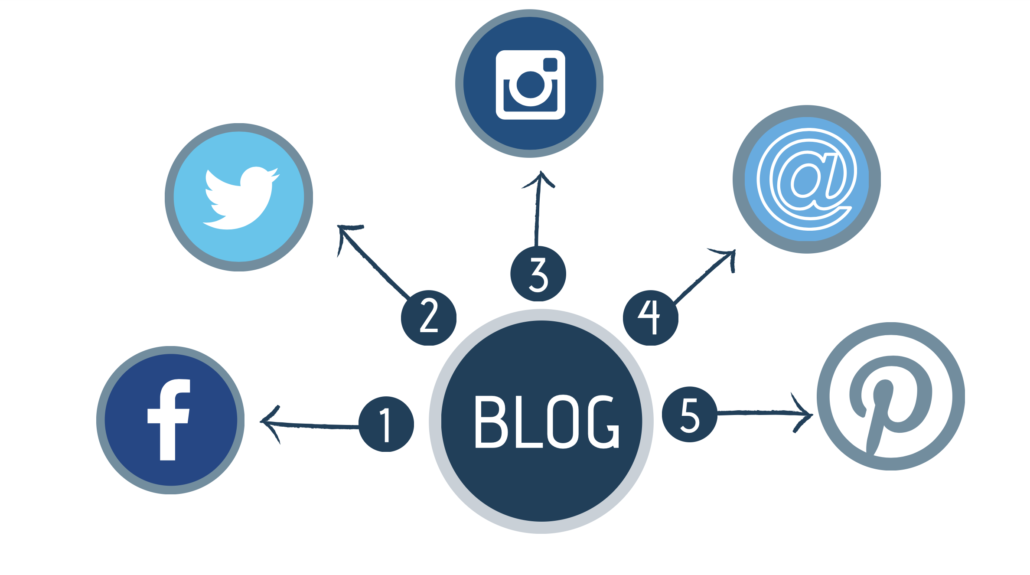
First and foremost, every blog deserves a Facebook post! Not only this, but every blog deserves to be activated with Paid Promotion on Facebook as well. When you’re putting together your blog post for Facebook, carefully consider how your blog content is related to specific niche markets that you can target. For example, if your blog is about wine tasting in the area, consider targeting your post to reach wine enthusiasts in feeder markets. When crafting your post, make sure to think about the small details, too, especially your link header text* and the image accompanying the link. Finally, include language that will encourage users to act!
*You can no longer edit the link header text when you are uploading your link to your post, you will likely have to think of this when you are crafting your post on the website side.
A great next step in your blog distribution is to support it by tweeting about it! We recommend thinking of three different ways to compose tweets on the subject. Since the Twitter algorithm seems to constantly be changing, it’s important that you trickle the distribution of your blog on Twitter throughout the week with different days and times to achieve best performance on the platform.
Whether you’re sharing your cool photography or fun times with friends, Burnsville has some awesome Instagram Hotspots for you! 📷
Check out our latest blog for the best photo ops and share your pics with us using #MyBurnsville
Click here: https://t.co/M0pnfrDXGF pic.twitter.com/8Wlj2K9pJ2
— Experience Burnsville (@burnsvillemncvb) July 12, 2019
Next up you’ll want to generate awareness of your blog on Instagram both in the feed and on your stories. Start by replacing the link in your bio with your new shortened link. This is especially important because links are not clickable in the captions of an Instagram photo! When you’re crafting your post, be sure that you’re posting it in a way that will resonate on Instagram. This means, use your best photo to make sure the post stops scrolling thumbs! You can also post about the blog on your story and give readers a snippet of what the blog contains to help encourage them to swipe up or click the link in your bio.
Read this blog for tips on putting together a noteworthy Instagram story.
Pinterest is a highly effective tool for supporting blog content for tourism as it can combine your images and links in a very appealing way. We recommend pinning every photo from your blog to Pinterest to ensure full coverage! Make sure you’re including the direct URL to your website to ensure highest possible performance and pull in traffic to your website.
E-Newsletter
Lastly, it’s vital to include your content in your tourism e-newsletter, as it’s a key tool in driving traffic to your website as well as keeping users informed on a regular basis. If you’re on a weekly blog distribution schedule (as opposed to monthly), you don’t have to include every piece of content that you write in your newsletter, as this could potentially be overwhelming for readers. But, if you’re having trouble deciding which blogs to include in your newsletter, consider taking a look at your most popular posts on your Google Analytics and go from there! For more tips on putting together a tourism e-newsletter, check out this blog.
It is critical to distribute your tourism blog across all digital platforms of your organization. This strategy will allow you to reach a wider variety of you audience as you aren’t focusing on just one platform. By following these distribution tips, your tourism blog will gain more traffic in no time! If you are looking for new ways to stay updated on your destination marketing, be sure to subscribe to our e-newsletter or follow us across social media at the links below!
How to Combat Dark Traffic in Google Analytics
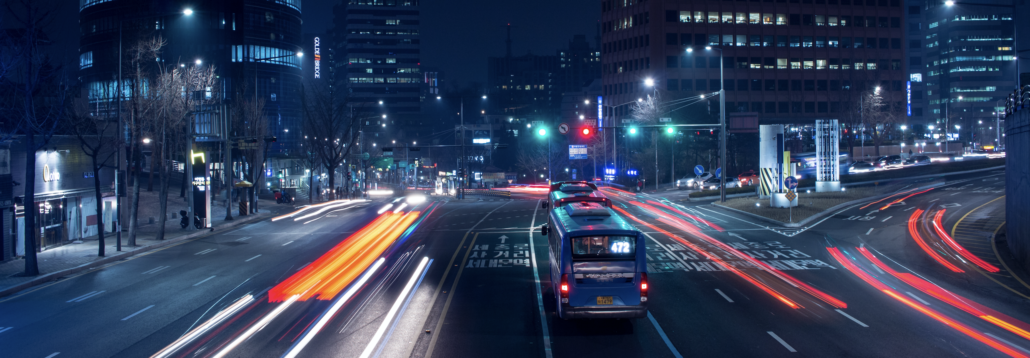
You should get credit where credit is due. Unfortunately, “Dark Traffic” can be hidden from Google Analytics and website clicks that you drive from social media might not be showing up. Read on to learn everything you need to know about “dark traffic” and what you should do to combat it.

First of all, dark traffic will show up in your Google Analytics as “direct/none.”Likely, you’ll see this in your top 5 ‘source / medium’. The standard belief is that direct traffic is from users typing in a URL or bookmarking the page, but this isn’t entirely true. Basically, it is a catch-all for traffic that Google Analytics can’t track where it’s coming from. For more info on direct traffic, click here.
However, dark traffic is any traffic that Google Analytics is improperly recording as ‘direct/none.’ This means that ‘direct/none’ traffic is being overreported and other sources, such as paid or social might be underreported. What does it mean for you? It means that your efforts could be going unacknowledged.

How does dark traffic occur? The two most common causes are URL shorteners like Bit.ly or Hootsuite, or Desktop programs and mobile applications like Outlook or Apple Mail. For example, if you post a shortened link on Twitter and a user clicks it, it does not calculate on Google Analytics. The same goes for when you send out an email newsletter and a user clicks on it from a mobile email application. In both of these instances, Google Analytics will incorrectly categorize it as ‘direct/none.’ Learn more here.

The answer is plain and simple: utilize UTM codes. A UTM code is a code that is easily added to the end of a URL to track the performance of your marketing efforts. This may sound confusing, but have no fear! As you should still use shortened links, Google offers a Campaign URL Builder(with a bit.ly shortener option) for you to utilize and there’s a Chrome extension that you can try, too!
When you’re using the tool, keep in mind that “source” and “medium” are the most important. Some platforms, likeFacebook and
Dark traffic,
For more ways to stay up-to-date on the latest digital marketing trends, be sure to subscribe to our e-newsletter and follow us across social media! If you’re looking for more direct help with your latest campaign, feel free reach out directly!

